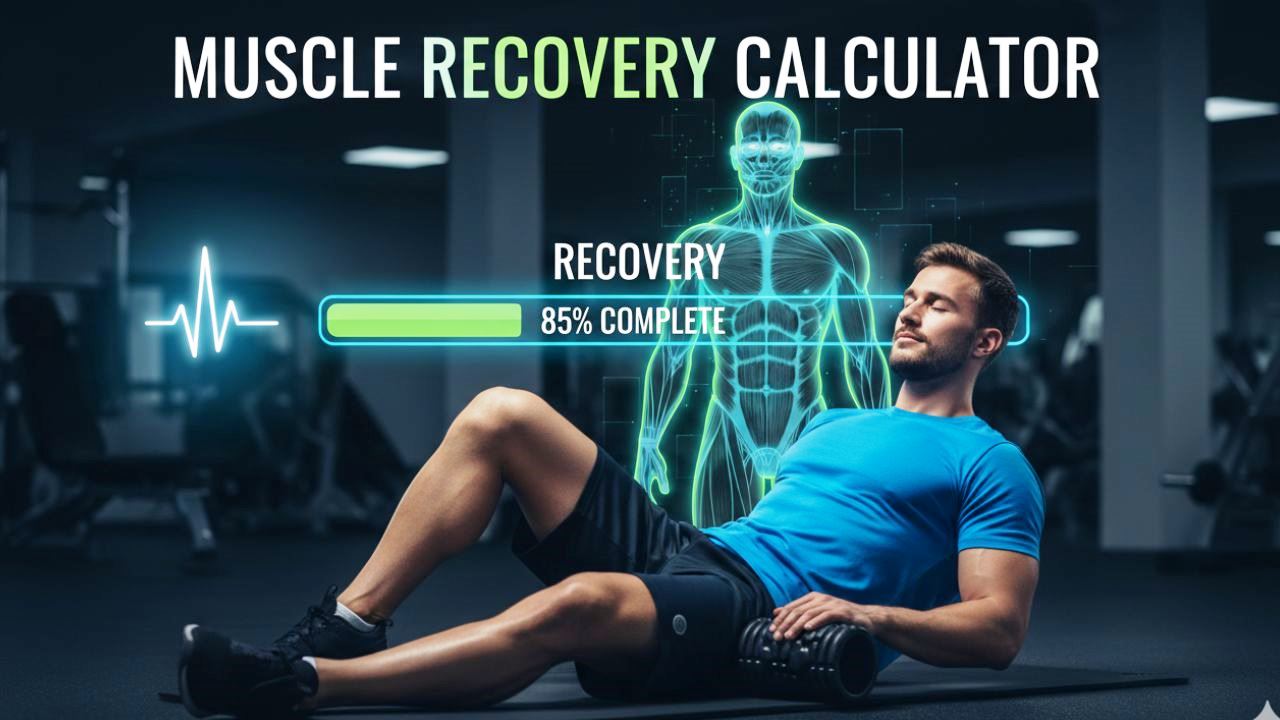Muscle Recovery Calculator
Calculate precise recovery times based on training intensity, volume, and muscle group. Optimize your workout schedule for maximum gains and injury prevention.

What Is Muscle Recovery?
Muscle recovery is the process your body undergoes to repair and strengthen muscle tissue after exercise. When you train, you create microscopic tears in muscle fibers. During recovery, your body repairs these tears, making muscles stronger and larger.
Recovery involves three main processes:
- Muscle Protein Synthesis: Building new muscle proteins to repair damaged fibers
- Glycogen Replenishment: Restoring energy stores depleted during exercise
- Inflammation Reduction: Clearing metabolic waste and reducing muscle soreness
Research shows that muscle protein synthesis remains elevated for 24-72 hours after training, depending on the intensity and volume of your workout. This is why proper recovery timing is crucial for muscle growth.
Studies on muscle recovery and nutrition demonstrate that strategic nutrition timing significantly impacts recovery speed.
How Long Do Muscles Take to Recover?
Recovery time varies significantly based on several factors:
Base Recovery Times by Muscle Group:
- Small Muscles (24-36 hours): Biceps, triceps, calves, abs
- Medium Muscles (36-48 hours): Shoulders, chest (with lighter training)
- Large Muscles (48-72 hours): Chest, back, quadriceps, hamstrings, glutes
Calculation: 48 hours (base) × 1.3 (heavy) × 1.0 (moderate volume) = 62 hours
Result: Wait approximately 2.5-3 days before training chest again
Research on exercise recovery timing confirms these muscle-specific recovery patterns.
Factors That Affect Recovery Speed
1. Training Intensity
Higher intensity training causes greater muscle damage and requires more recovery time. Training at 80-90% of your maximum creates significantly more microtears than lighter training at 60-70%. Calculate your exact training intensity with our Workout Intensity Calculator.
2. Training Volume
More sets mean more cumulative muscle damage. Research shows that 10-20 sets per muscle group per week is optimal for growth, but exceeding this can prolong recovery.
3. Training Experience
Advanced lifters recover faster than beginners because their bodies have adapted to training stress. A beginner might need 30% more recovery time than an advanced athlete.
4. Age
Muscle protein synthesis decreases with age. Athletes over 40 may need 10-20% more recovery time compared to those in their 20s due to reduced protein synthesis rates and longer inflammation periods.
5. Sleep Quality
Most muscle repair occurs during deep sleep. Getting less than 7 hours of sleep can extend recovery time by 20-40%. Growth hormone, crucial for recovery, is primarily released during deep sleep phases.
6. Nutrition
Protein intake of 1.6-2.2g per kg of body weight daily supports optimal recovery. Consuming 20-40g of protein within 2 hours post-workout maximizes muscle protein synthesis.
References
- Caballero-García, A., & Córdova-Martínez, A. (2022). Muscle Recovery and Nutrition. Nutrients, 14(12), 2416. https://doi.org/10.3390/nu14122416
- Peake, J. M. (2019). Recovery after exercise: What is the current state of play? Current Opinion in Physiology, 10, 17-26. https://doi.org/10.1016/j.cophys.2019.03.007
- Cimadevilla, E., María, A., Ramón, J., Pablo, J., Aránzazu, M., Vicente, M., Hernández Lougedo, J., & Luis, J. (2020). Muscle Recovery after a Single Bout of Functional Fitness Training. International Journal of Environmental Research and Public Health, 18(12), 6634. https://doi.org/10.3390/ijerph18126634
